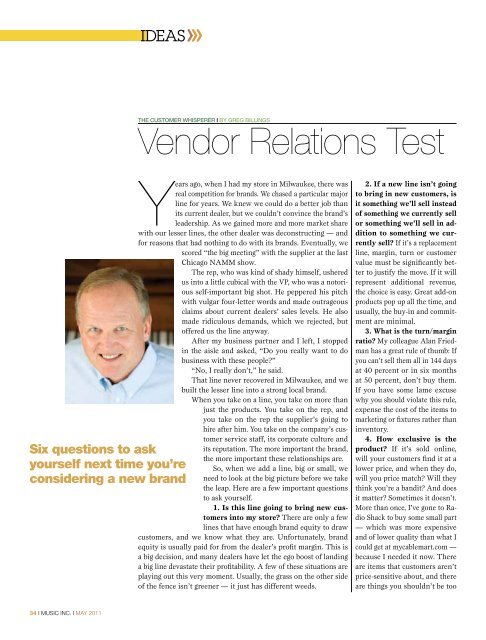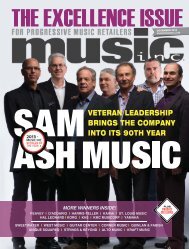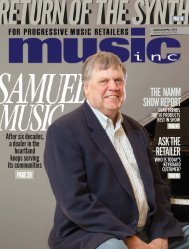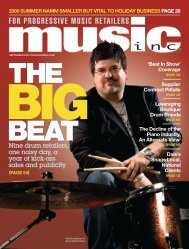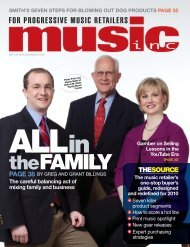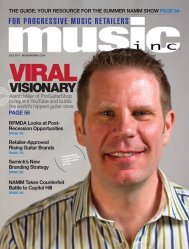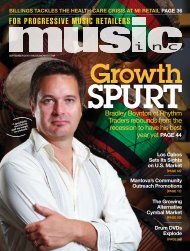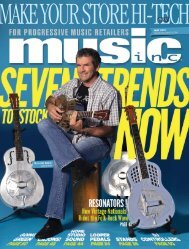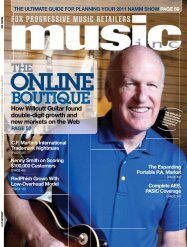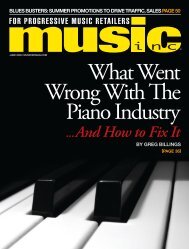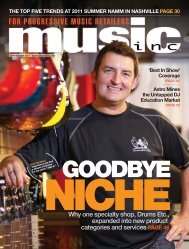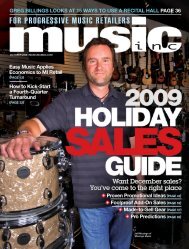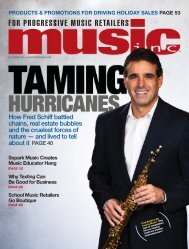You also want an ePaper? Increase the reach of your titles
YUMPU automatically turns print PDFs into web optimized ePapers that Google loves.
Six questions to ask<br />
yourself next time you’re<br />
considering a new brand<br />
34 I MUSIC INC. I MAY 2011<br />
THE cUSToMER WHiSPERER i BY GREG BilliNGS<br />
Vendor Relations Test<br />
Years ago, when I had my store in Milwaukee, there was<br />
real competition for brands. We chased a particular major<br />
line for years. We knew we could do a better job than<br />
its current dealer, but we couldn’t convince the brand’s<br />
leadership. As we gained more and more market share<br />
with our lesser lines, the other dealer was deconstructing — and<br />
for reasons that had nothing to do with its brands. Eventually, we<br />
scored “the big meeting” with the supplier at the last<br />
Chicago NAMM show.<br />
The rep, who was kind of shady himself, ushered<br />
us into a little cubical with the VP, who was a notorious<br />
self-important big shot. He peppered his pitch<br />
with vulgar four-letter words and made outrageous<br />
claims about current dealers’ sales levels. He also<br />
made ridiculous demands, which we rejected, but<br />
offered us the line anyway.<br />
After my business partner and I left, I stopped<br />
in the aisle and asked, “Do you really want to do<br />
business with these people?”<br />
“No, I really don’t,” he said.<br />
That line never recovered in Milwaukee, and we<br />
built the lesser line into a strong local brand.<br />
When you take on a line, you take on more than<br />
just the products. You take on the rep, and<br />
you take on the rep the supplier’s going to<br />
hire after him. You take on the company’s customer<br />
service staff, its corporate culture and<br />
its reputation. The more important the brand,<br />
the more important these relationships are.<br />
So, when we add a line, big or small, we<br />
need to look at the big picture before we take<br />
the leap. Here are a few important questions<br />
to ask yourself.<br />
1. Is this line going to bring new customers<br />
into my store? There are only a few<br />
lines that have enough brand equity to draw<br />
customers, and we know what they are. Unfortunately, brand<br />
equity is usually paid for from the dealer’s profit margin. This is<br />
a big decision, and many dealers have let the ego boost of landing<br />
a big line devastate their profitability. A few of these situations are<br />
playing out this very moment. Usually, the grass on the other side<br />
of the fence isn’t greener — it just has different weeds.<br />
2. If a new line isn’t going<br />
to bring in new customers, is<br />
it something we’ll sell instead<br />
of something we currently sell<br />
or something we’ll sell in addition<br />
to something we currently<br />
sell? If it’s a replacement<br />
line, margin, turn or customer<br />
value must be significantly better<br />
to justify the move. If it will<br />
represent additional revenue,<br />
the choice is easy. Great add-on<br />
products pop up all the time, and<br />
usually, the buy-in and commitment<br />
are minimal.<br />
3. What is the turn/margin<br />
ratio? My colleague Alan Friedman<br />
has a great rule of thumb: If<br />
you can’t sell them all in 144 days<br />
at 40 percent or in six months<br />
at 50 percent, don’t buy them.<br />
If you have some lame excuse<br />
why you should violate this rule,<br />
expense the cost of the items to<br />
marketing or fixtures rather than<br />
inventory.<br />
4. How exclusive is the<br />
product? If it’s sold online,<br />
will your customers find it at a<br />
lower price, and when they do,<br />
will you price match? Will they<br />
think you’re a bandit? And does<br />
it matter? Sometimes it doesn’t.<br />
More than once, I’ve gone to Radio<br />
Shack to buy some small part<br />
— which was more expensive<br />
and of lower quality than what I<br />
could get at mycablemart.com —<br />
because I needed it now. There<br />
are items that customers aren’t<br />
price-sensitive about, and there<br />
are things you shouldn’t be too


